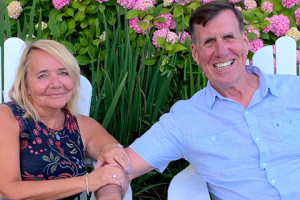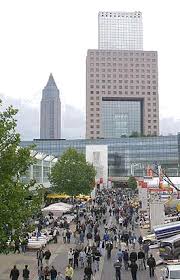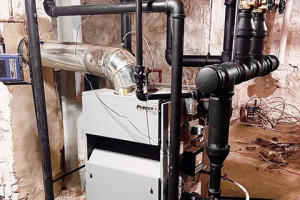
Hello, old friend. I’m writing today to say thanks, and to say farewell. This will be my last column.

I first went to the big ISH fair in Frankfurt, Germany in 1991 with two buddies, and I think we three were joined by only about 17 other Americans that year. ISH was larger than the Fourth of July, even then, but we were still messing around with standing pilots and oversized everything in those days, and we were certain that the rest of the world would catch up with us, given enough time. After all, we're Americans.
It didn't work out that way, though. Most of the products and technologies we saw at ISH in 1991 were making their way here before long, mainly through the hard work of missionary reps who just kept knocking on doors. Much of what was new got pooh-poohed by the American heating community at first. That's just our way. This new stuff was too exotic, and too expensive, and too metric, And it was technology that the American public would never accept. We knew this without even asking them.
But then, like barcodes and designer coffee, it all started to catch on in a big way, and it gained steam as the '90s rolled toward the turn of the century, and now we take New Hydronics as a commonplace, accepted fact.
Boilers don't really need chimneys, and you can heat a building with water that's not much hotter than what you'd use to shower. And circulators can, and should be, smart enough to know when to slow down as valves close throughout the system, and those valves should be able to tell the difference in temperature within a degree and, yes, we can save energy. And the public will accept all of this, as long as the installer believes in it first, and that is happening more each day.
It's like a river, this ISH. It never stops moving. Last March in Frankfurt, I looked at new boilers that burn wood pellets, and lots of heat pumps. I have been seeing wood-fired boilers for the past 10 years at ISH, and each year more of them appear, but this past March, they were everywhere.
Now, you might think that burning wood is a dirty business, and that Europeans, being so green, would shy from this practice, but it turns out that wood is the greenest fuel of all. Burning wood has become the key to what the Europeans call being, "carbon neutral." It took me some time to get all of this though my thick skull, but the more I thought about it, the more sense it made.
It works like this. When you burn wood you release carbon dioxide, which is a greenhouse gas, but if you were to let nature take its course and leave the tree alone, sooner or later it would fall to the ground and rot. And when it does, it will release the exact same amount of carbon dioxide into the atmosphere as it will if you burn it.
Sure, burning the tree for fuel speeds up the process, but if you plant a new tree it will absorb the CO2 from the tree you burned. And here's the key part: Since the trees are already on the surface of the earth, this is considered "old carbon." It's been here on the surface and in the atmosphere for millions of years in one form or another. The trouble, as environmentalists see things, begins when you mine the earth for oil and natural gas, because by doing this, you're bringing "new carbon" to the surface. You're increasing the overall amount of carbon on the surface, and that's the problem.
So by burning wood, or by using ground-source heat pumps, we move closer to becoming "carbon neutral," and that's a big part of what's driving the European heating market right now, and it's changing things quickly. In 2006, and for the first time ever, the combined sale of wood-pellet boilers and ground-source heat pumps exceeded the total sale of oil-fired boilers in all of Europe, and cut significantly into the sales of gas-fired boilers as well. The public favor is moving away from fossil fuels and toward these other options, and the major manufacturers are responding to this with some amazing products. These new boilers feed themselves wood pellets, and operate on outdoor-reset controls, and they burn clean.
Keep an eye on this technology. We have lots of wood in this country.
And then there's solar. I saw a tank-in-a-tank storage unit at the Buderus booth that had me smiling. The water from the solar panel enters the inner tank through an ingenious baffling system and then heats the domestic hot water. The DHW, in turn, heats the water in the outer tank, which then flows to radiant floor panels to heat the house. Solar heats domestic; domestic heats space-heating water, and all from one tank. And if the sun's not shining, a wall-hung condensing boiler steps up and carries the load. There can also be a wood stove with a back-burner tied into all of this. And figuring out what flow goes where, and when, is a circulator/valve/control module that's designed to do just what you need it to do. You tell the manufacturer what you want to achieve, and they give you a plug-and-play module that will get the job done. More and more of European hydronics is plug and play.
And none of this is that far off. Watch.
We spent some days at the show and then flew up to Denmark to visit with the good folks at Grundfos. They have an ultra-modern complex in a lovely setting, and we got to meet the son of the founder, who told us how his dad started the business in the basement of that little building over there by inventing a pressure pump that would help with the problems facing most Europeans following World War II. "Grundfos," in Danish, means "ground water" (I didn't know that; did you know that?).
There's a museum at Grundfos, and I got to see that original pump that would take water from the ground and pressurize it so that people could have a decent shower. Acres and acres of international manufacturing wizardry sprang from that one pump, and I get a kick out of seeing artifacts like that one. I enjoyed the hospitality and enthusiasm of these smart, hard-working Danes. Good folks.
As we drove from Copenhagen over the second-longest suspension bridge in the world, and into the core of Denmark we passed hundreds and hundreds of windmills. I asked about these, and was told that the farmers join together in cooperatives and put them up. They then harvest the wind like a crop, and sell it to the power company. To me, they're quite beautiful, these whimsical pinwheels that dot the land, and I love what they represent. I wish we had more of them in America.
The income tax in Denmark hovers around 50%, but then you never have to pay for school, or doctors and dentists, or your retirement. You're taken care of from cradle to grave, and it's all quite un-American. Grundfos has a special part of their factory where older employees, or employees who have become disabled, can still go to work if they want to work. They're given the easier jobs, and made to feel wanted and important.
And if you want to own a car in Denmark, you first negotiate the price of the vehicle, and then you have to pay a sales tax of 180%. If it's a motorcycle you crave, the tax on that will be 200%. Buy three, get one. All of this is, of course, also very un-American, and it causes most Danes to take to their bicycles. The bikes are everywhere and they all share them. Few bikes are locked. If someone takes your bike, you just take someone else's. It's all good. Just about every road has a bike path running alongside it, and there are big bike garages at the train stations, and even at the Grundfos plant.
I'm there for days and something is nagging at me. The people are gorgeous, and I can't stop looking at them. But what is it that’s nagging me?
And then it hits me! There are no fat people in this country. Look around. You can't see one single chubby anywhere. It's the bicycles. The people are trim and fit and beautiful because they’re riding everywhere, and not sitting on their butts all day long.
I'm in a restaurant and I ask the waitress, "Excuse me, where are all the fat people?" And she smiles at me, and in perfect English, says, "They're in America."
So much to learn.

Hello, old friend. I’m writing today to say thanks, and to say farewell. This will be my last column.

My six-year-old grandboy, Brendan, was in the vestibule of the diner when the bubblegum machine caught his attention. It was one of those spiral models that appeared in t...

Subdural posed a question on The Wall at HeatingHelp.com in the Strictly Steam section, where some of the sharpest knives in the drawer post every day. The question was a...